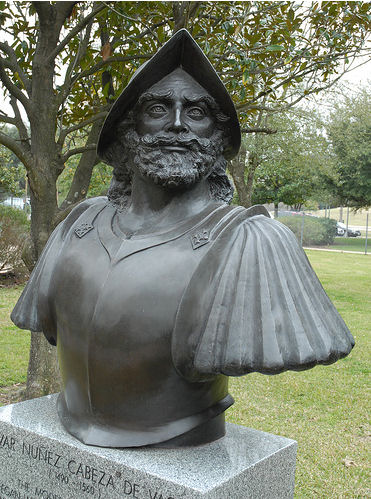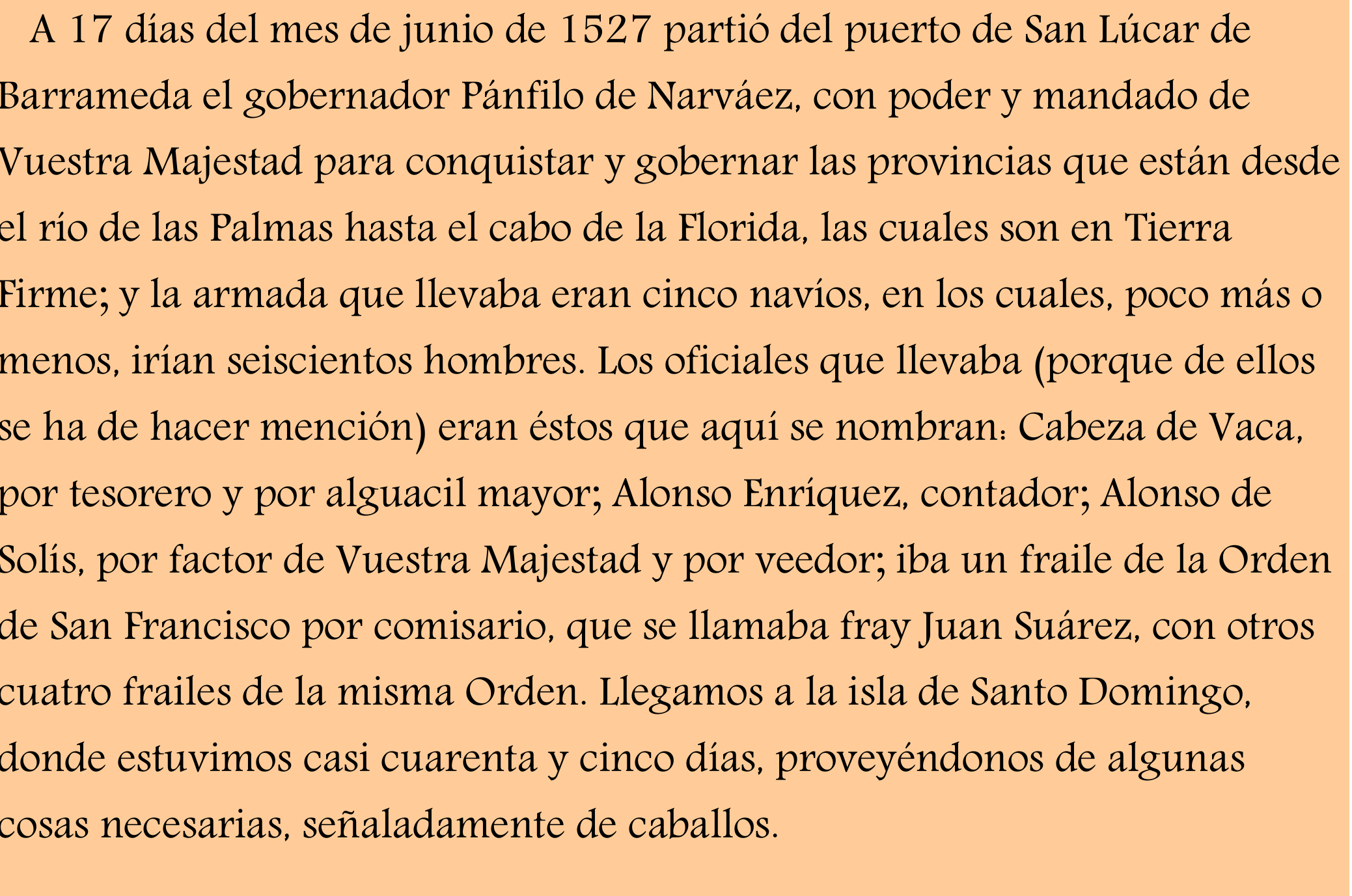 Álvar Núñez Cabeza de Vaca was a Spanish explorer who lived from 1488 to 1558, or thereabouts. He was a very interesting man, and unlike some other explorers, he was not a conqueror, so much as someone who went and lived with the natives and learned their ways and tried to behave humanely, whenever he had any power to do so.
Álvar Núñez Cabeza de Vaca was a Spanish explorer who lived from 1488 to 1558, or thereabouts. He was a very interesting man, and unlike some other explorers, he was not a conqueror, so much as someone who went and lived with the natives and learned their ways and tried to behave humanely, whenever he had any power to do so.
Much of Cabeza de Vaca’s life involved captivity and submission to others. He knew hunger, and he experienced first hand what it was like to be enslaved by others. That may be why, whenever he did have power, he tried not to trample on the rights of those he was supposed to govern.
Álvar Núñez Cabeza de Vaca was not just an explorer and a politician. He was also a writer, just like many of us here on PubWages. He was an author of a very interesting book, or should I say two books bound up into one. Naufragios y Comentarios is what we call it today, but the first part is a self contained book about his shipwreck and living among the natives in North America, whereas the second part, Comentarios, was about his experiences in South America, which were more as a colonist, and less as an explorer, alhtough he did explore there, too. He was accused of being a poor administrator, and his conflict with authority is a theme in all his writings.
Why I am writing this
My interest in Cabeza de Vaca is genuine. So genuine, in fact, that I wrote a novel that incorporates many of the experiences of Álvar Núñez Cabeza de Vaca into its intricate plot. The name of my novel is Vacuum County, and it is going to come out in two days, on April 19, 2012.
Here is the trailer for Vacuum County:
As part of the promotion of my novel, I am finding it expedient to promote also some of the source materials on which the novel is based.
Why? Because keyword research is the name of the game in book publishing today. Most people discover new books online, and they do this by looking up keywords that they are interested in.
Because I know that many people are interested in Cabeza de Vaca and his writing, I have decided to add a featured column here on PubWages that is dedicated to Álvar Núñez Cabeza de Vaca and his writings.
Article or Blog?
Is this an article or a blog, you may ask yourself? Well, it’s a blog based in article directory. PubWages is an article directory. Traveling with Cabeza de Vaca is going to be a recurring feature on PubWages, kind of the way a writer on a newspaper can have a recurring column with its own title and theme.
Here is how I am planning to do this. Every time I add a new entry to this column, I will scan in a part of the Cabeza de Vaca text, and then we will talk about what it means. Comments, suggestions and even guest posts are welcome!
Copyright Issues versus Duplicate Content Issues.
It probably goes without saying that while I am not the author of Naufragios y Comentarios, that work is long out of copyright, if indeed it ever was in copyright.
However, here on the internet there is a second issue, besides copyright infringement, that we all have to deal with. Google penalizes us for using “duplicate content.” The penalty for duplicate content has nothing much to do with whether you have the right to use the content, are its creator, or are plagiarizing someone else. You can be penalized for copying your own article to another site, even though you have every legal right to do that as an author. Google wants to rate sites for their originality, and by originality they don’t mean thinking outside the box. They mean: you can’t find this content anywhere else!
Now, of course, the text of Naufragios and Comentarios is freely available of the net. Anybody can find it, if they look hard enough. So the Google bots, who have no minds of their own, are going to see if I copy word for word what Cabeza de Vaca said, and they won’t care that it is perfectly legal and appropriate for me to do so, as I am neither infringing on Cabeza de Vaca’s copyright nor plagiarizing. To get around the duplicate content penalty, I will upload texts from the Cabeza de Vaca books as pictures, and the bots will not know that these pictures have words in them, and that the words are duplicate content.
Today’s Text
Here is today’s text from the writings Álvar Núñez Cabeza de Vaca:
Now, of course, someone might steal this beautifully typeset version of the opening paragraph of Cabeza de Vaca’s text, but if they do so, they are infringing on my copyright in the typesetting that I did myself. Also their copy of my copy would be duplicate content.
So what do we learn from reading this passage? We learn that on the seventeenth of May in 1527, Cabeza de Vaca, along with Governor Panfilo de Narvaez, left the port of San Lucar de Barrameda. The recital is addressed to “Your Majesty” and while this is not included in the text, I will tell you who this refers to: the Emperor Carlos the first, who was Emperor of both Spain and Germany at that time.
Panfilo de Naravaez was given authority by Carlos I to conquer and govern the provinces that were located from the river of “las Palmas” to the cape of Florida, at least those parts that were on dry land and not immersed in water.
To the end of achieving this conquest, here is the armed force that Panfilo de Narvaez had: five ships in which there were more or less sixty men. Cabeza de Vaca was the treasurer. Alonso Enriquez was the accountant. Alonso de Solis was an agent and overseer for the King. There was a brother of the order of San Francisco, Juan Suarez, who served as commissioner, and there were four other brothers of that order.
They arrived at the Isle of Santo Domingo, where they stayed for about forty-five days, and they stocked up on supplies and horses.
This was an off-the-cuff translation, and if you have you have some corrections to make, please feel free to do so in the comments.
Anyway, this is how our story begins. Please stay tuned for more in later entries of Traveling with Cabeza de Vaca.

Order here:: Vacuum County



In general the Spaniards had a better track record for colonization than the British. Even the French did since they married among the Native Americans, like the Spaniards did. For some reason the British have always had this superiority complex when it came to their colonies, and people who intermarried with natives were looked down upon. Some of my British-American ancestors did marry among the Native Americans, hence my ancestry, but it was far more common for Spaniards to do so. Even the conquerors like Cortez were not completely loathed since many people were upset with the Aztecs blood hungry rule, and many different native groups helped him to over throw them. Even Cortez was respected among the Native Americans of Mexico because he had a mistress who was of Native American, and he is considered the father of the mestizo people, or the mixing of people. However, I do agree that Cabeza de Vaca was more of a noble man in that he did not conquer like Pizarro or Cortez did.
One professor I had of Mexican history liked to point out Native Americans were not exploited in Mexico, and they could actually go to court and fight for their land rights. In the twentieth and twenty-first century most of the presidents of Mexico have been of Spanish descent, but Benito Juarez was Native American and president of Mexico in the 1800′s when Americans would never have thought of electing a president with native blood. Actually only two US presidents have been part Native American, Calvin Coolidge and Barack Obama, and their ancestry is miniscule. We also have the sad history of the Cherokee Removal that violated the Supreme Court ruling saying the Cherokees could stay on their land. Spanish colonies overall just have a better track record for how they interacted with the indigenous population.
Yes, you are probably right that the British were more racist than the Spanish and the French. The Spanish did a better job of assimilating native populations than the British, and intermarriage was part of that process.
Pingback: Book Review: Good Faith and Truthful Ignorance: A Case of Transatlantic Bigamy | PubWages
Pingback: What is Vacuum County All About? | PubWages